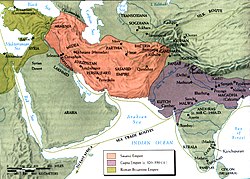Gupta Empire
This article needs to be wikified. (May 2024) |
Gupta Empire | |||||||||||||||||||||||||
|---|---|---|---|---|---|---|---|---|---|---|---|---|---|---|---|---|---|---|---|---|---|---|---|---|---|
| c. 319 CE–c. 550 CE | |||||||||||||||||||||||||
![Map of the Gupta Empire c. 420 CE, according to Joseph E. Schwartzberg, with contemporary polities[1]](http://upload.wikimedia.org/wikipedia/commons/thumb/3/34/Map_of_the_Gupta_Empire.png/250px-Map_of_the_Gupta_Empire.png) Map of the Gupta Empire c. 420 CE, according to Joseph E. Schwartzberg, with contemporary polities[1] | |||||||||||||||||||||||||
| Status | Empire | ||||||||||||||||||||||||
| Capital | Pataliputra Ujjain Ayodhya[2][3] | ||||||||||||||||||||||||
| Common languages | Sanskrit (literary and academic); Prakrit (vernacular) | ||||||||||||||||||||||||
| Religion | |||||||||||||||||||||||||
| Government | Monarchy | ||||||||||||||||||||||||
| Maharajadhiraja | |||||||||||||||||||||||||
• c. Early 3rd century CE | Gupta (first) | ||||||||||||||||||||||||
• c. 280-319 CE | Ghatotkacha | ||||||||||||||||||||||||
• c. 319-335 CE | Chandragupta I | ||||||||||||||||||||||||
• c. 335-375 CE | Samudragupta | ||||||||||||||||||||||||
• c. 375-415 CE | Chandragupta II | ||||||||||||||||||||||||
• c. 415-455 CE | Kumaragupta I | ||||||||||||||||||||||||
• c. 455-467 CE | Skandagupta | ||||||||||||||||||||||||
• c. 540-550 CE | Vishnugupta (last) | ||||||||||||||||||||||||
| Historical era | Ancient India | ||||||||||||||||||||||||
• Established | c. 319 CE | ||||||||||||||||||||||||
• Disestablished | c. 550 CE | ||||||||||||||||||||||||
| Area | |||||||||||||||||||||||||
| 400 est.[4] (high-end estimate of peak area) | 3,500,000 km2 (1,400,000 sq mi) | ||||||||||||||||||||||||
| 440 est.[5] (low-end estimate of peak area) | 1,700,000 km2 (660,000 sq mi) | ||||||||||||||||||||||||
| Currency | Dinars, Cowries | ||||||||||||||||||||||||
| |||||||||||||||||||||||||
| Today part of | |||||||||||||||||||||||||
This article does not have any sources. (October 2023) |

The Gupta Empire was ruled by members of the Gupta dynasty from around 320 to 550 AD and covered most of North-central India and Eastern Pakistan. The time of the Gupta Empire is reffered to as Golden Age of science, mathematics, astronomy, religion and philosophy in South Asia. The kings of this dynasty favour Hinduism and Buddhism.
The Guptas most probably came from Bengal. At the beginning of the 4th century the Guptas ruled a few small Hindu kingdoms in Magadha and around modern-day Uttar Pradesh.
We get plenty of information about this dynasty through coins, inscriptions, monuments, and Sanskrit writings. The Gupta rulers were great conquerors and good administrators. This brought on a series of invasions that weakened the empire, but many of their cultural and intellectual achievements were saved and transmitted to other cultures and live on today. Fa Hien visited India during the reign of Chandragupta II and stayed in this country for several years.
People lived a simple life. Commodities were affordable and all round prosperity ensured that their requirements were met easily. They preferred vegetarianism and shunned alcoholic beverages. Gold and silver coins were issued in great numbers which is a general indicative of the health of the economy. Trade and commerce flourished both within the country and outside. Silk, cotton, spices, medicine, priceless gemstones, pearl, precious metal and steel were exported by sea.
Gupta dynasty[change | change source]
The Gupta dynasty ruled by the Gupta Empire of South Asia, from around 320 to 550.
Some of its main rulers were:
- Chandragupta
- Samudragupta
- Ramagupta
- Chandragupta II
- Kumaragupta I
- Skandagupta
- Narasimhagupta
- Buddhagupta
- Purugupta
- Vishnugupta
- Pushpak
Coins[change | change source]
The Guptas used coinage across their empire.This showed both their wealth-as some coins were trying to unify the empire by using the same coins over the empire.
Further reading[change | change source]
- Karls, Farah. World History The Human Experience.
| Preceded by Kanva dynasty |
Magadha dynasties 240-550 AD |
Succeeded by Pala dynasty |
Other websites[change | change source]
- Frontline Article on Gupta Period Art Archived 2008-12-04 at the Wayback Machine
- ↑ Schwartzberg, Joseph E. (1978). A Historical atlas of South Asia. Chicago: University of Chicago Press. p. 145, map XIV.1 (j); p.25. ISBN 0226742210. Archived from the original on 24 February 2021. Retrieved 12 February 2022.
- ↑ Bakker, Hans (1984), Ayodhya, Part 1: The History of Ayodhya from the seventh century BC to the middle of the 18th century, Groningen: Egbert Forsten, p. 12, ISBN 90-6980-007-1
- ↑ * Hans T. Bakker (1982). "The rise of Ayodhya as a place of pilgrimage". Indo-Iranian Journal. 24 (2): 105. doi:10.1163/000000082790081267. S2CID 161957449.
During the reign of either the emperor Kumāragupta or, more probably , that of his successor Skandagupta ( AD 455–467 ), the capital of the empire was moved from Pāțaliputra to Ayodhyā...
- ↑ Turchin, Peter; Adams, Jonathan M.; Hall, Thomas D (December 2006). "East-West Orientation of Historical Empires". Journal of World-Systems Research. 12 (2): 223. doi:10.5195/JWSR.2006.369. ISSN 1076-156X.
- ↑ Taagepera, Rein (1979). "Size and Duration of Empires: Growth-Decline Curves, 600 B.C. to 600 A.D". Social Science History. 3 (3/4): 121. doi:10.2307/1170959. JSTOR 1170959.
